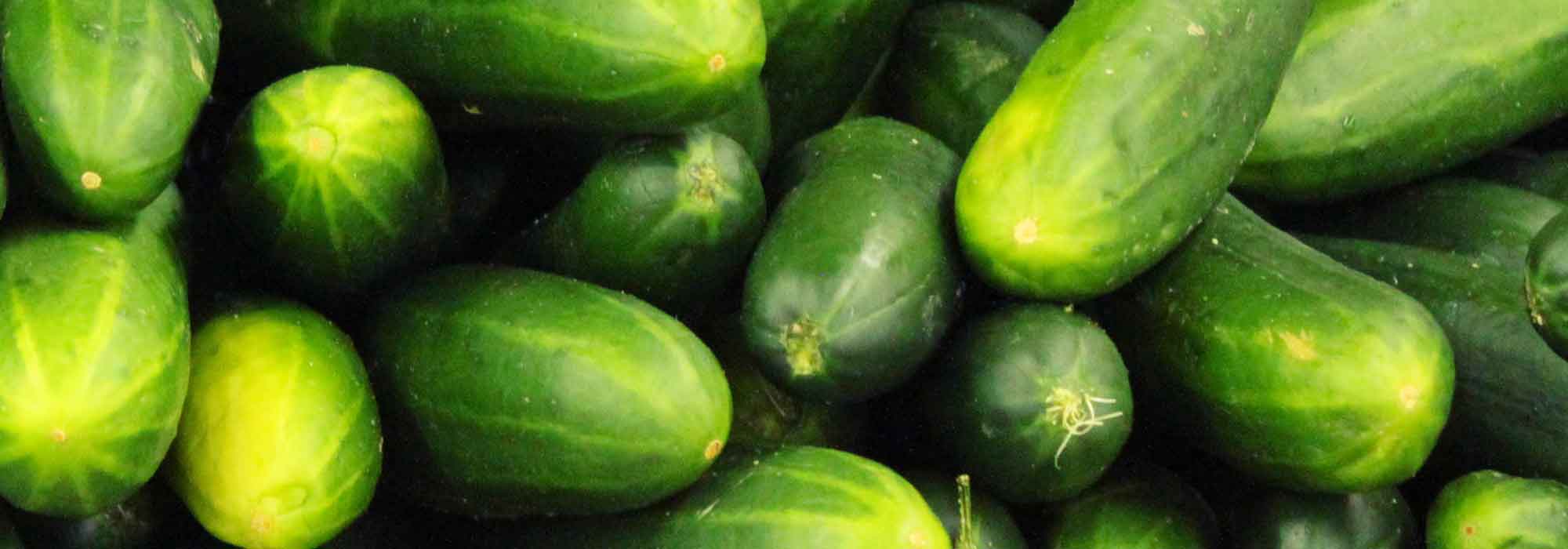
Cucumber and gherkin: sowing, planting, cultivation, pruning
Contents
Cucumber and gherkin in a nutshell
- Cucumbers and gherkins thrive in rich, humus-bearing soil that is cool, loose, and light, in a sunny location.
- They are both of the same species: gherkins are cucumbers harvested prematurely. Some varieties are better suited for gherkin production.
- Sowing takes place from April, in buckets and in a warm environment, or directly in the ground in May. The young plants are installed in the garden after mid-May.
- They are quite thirsty vegetables that need to be watered regularly; they can be trained on supports to save space and facilitate harvesting!
- Cucumber is a key summer vegetable with its refreshing, remineralising, and low-calorie qualities! Gherkins are best when pickled in vinegar.
A word from our expert
Cucumber and gherkin are two fruit-vegetables from the large family of Cucurbitaceae which includes many vegetable plants such as melons, courgettes, watermelons, etc. Cucumber is one of the flagship vegetables of summer; it is probably its refreshing and low-calorie nature that justifies this attraction to this vegetable. Gherkin is slightly less popular as it needs to be pickled and accompanied by small onions, peppercorns, and tarragon to express its full flavour. However, I can tell you that homemade gherkins are definitely worth it!
There are several types of cucumbers: Dutch-type varieties that are intended for greenhouse cultivation, such as the ‘Carmen’ variety, and short-type varieties suitable for open ground cultivation like ‘Le Généreux’, a Vilmorin selection, and ‘Vert Long Maraîcher’, known for its good yield and sweet, crunchy white flesh.
Historically, gherkins are cucumbers whose fruits are harvested small; varieties have since been selected to suit the characteristics of gherkins. A typical and well-known variety is ‘Fin de Meaux’, which produces small fruits of good taste quality. Also worth discovering is the gherkin ‘Russe’ with smooth fruits, to be harvested when they are the size of an egg.
There are also some uncommon, exotic cucumbers, such as Kenyan Cucumber or Snake Cucumber, which require a lot of heat to produce well. I must also mention melothria, ideal if you often have diseases with your cucumbers. Indeed, this cucumber from a different botanical genus is very resistant to diseases!
In the vegetable garden, cucumbers and gherkins prefer light, loose, cool soils rich in humus. They enjoy sunny exposures and temperatures between 18 and 22°C. These are quite water-hungry vegetables that need to be watered regularly. Additionally, they are sensitive to certain diseases such as powdery mildew and red spider mite… but by following our advice, you will prevent and treat these diseases naturally.
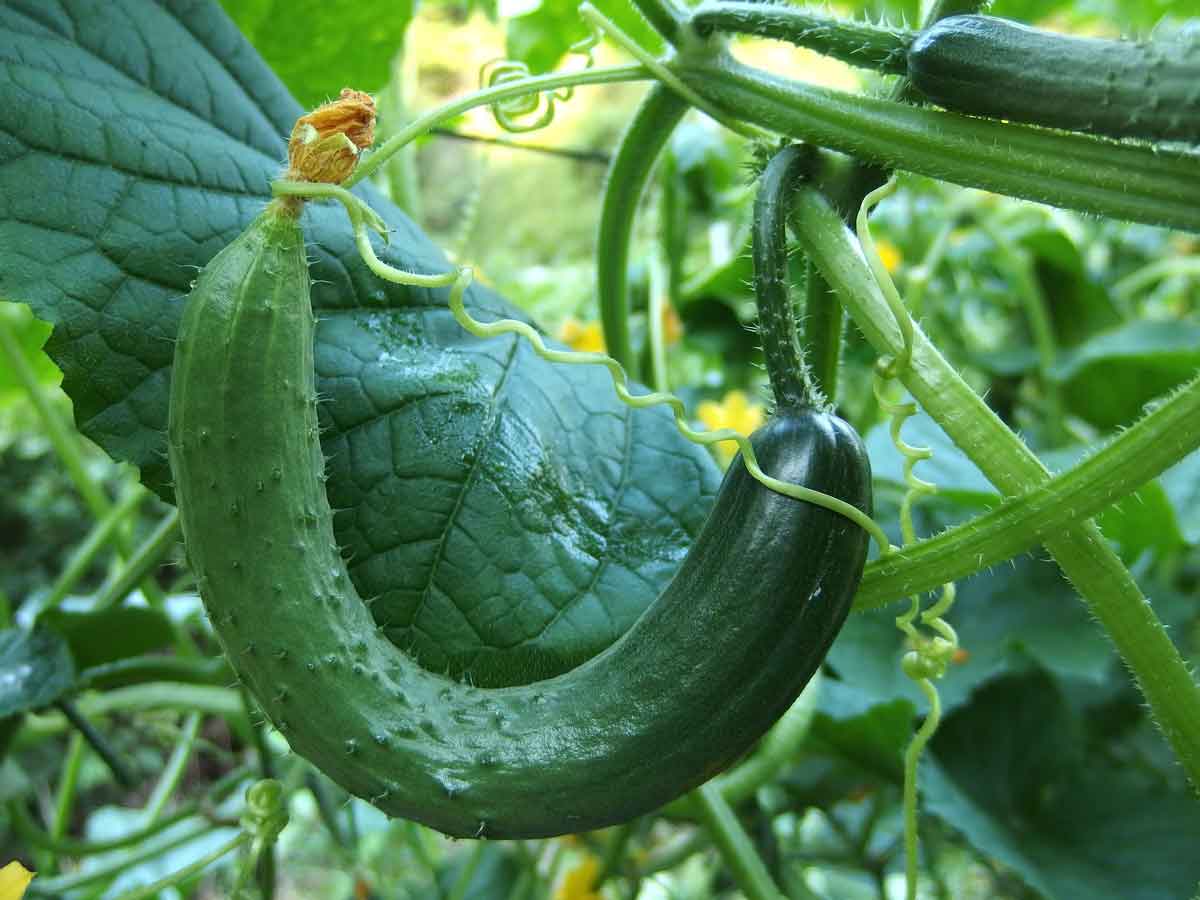
Description and Botany
Botanical data
- Latin name Cucumis sativus
- Family Cucurbitaceae
- Common name Cucumber
- Flowering Annual
- Height up to 10 years
- Exposure Sun
- Soil type rich, loose, deep, cool in summer
- Hardiness 0°C
Cucumber is a plant native to India where its wild ancestor (Cucumis hardwickii) grew in the valleys of the Himalayas. It was domesticated over 3000 years ago, in China, the Near East, and then in ancient Egypt. It arrived in Europe about 2000 years ago.
The cucumber – Cucumis sativus – is an annual fruit-vegetable of the Cucurbitaceae family, which includes squashes and many cultivated plants. The genus Cucumis comprises about thirty known species, including melon (Cucumis melo). Gherkins are cucumbers whose varieties have been selected for their small fruits. Thus, we can classify cucumbers into different types:
- Dutch type (or greenhouse cucumber): long fruits with smooth skin, without bitterness
- Short type (or field cucumber): short and slightly spiny fruits, some varieties are bitter
- Small fruit for pickling: gherkins
- Beit-alpha type: Mini cucumber, smooth and shiny, without bitterness
Cucumber is a plant with a creeping habit that can spread over several metres. Its leaves with long petioles and large laminae are palmate and slightly dentate. They are arranged alternately on the voluble stem, which has a pentagonal section. Tendrils emerge from the base of the petiole and allow the plant to cling to neighbouring supports. Cucumber is a monoecious species, bearing both male and female flowers on the same plant but in different locations. Both types of flowers are pale yellow. The female flower, which bears the fruit, is fertilised by pollen from a male flower of the same variety or another variety; cross-fertilisation is predominant (allogamy). Pollination is also entomophilous, ensured by insects. A fertilised female flower will produce a fruit characteristic of the variety. The fruit is a cylindrical berry that, when ripe, contains pale, flattened seeds about one centimetre long.
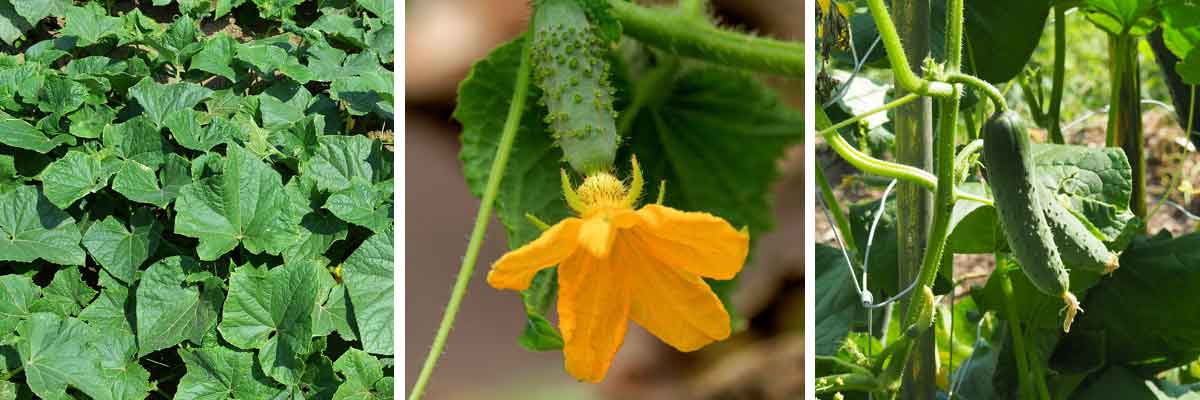
Cucumber leaves – Female flower – Formed fruit
Read also
Powdery mildew or white diseaseCucumber and gherkin varieties
Most cultivated varieties of cucumbers are either Dutch or short types, while gherkin varieties are selected for the flavour of their early-harvested fruits. Discover our selection of varieties!
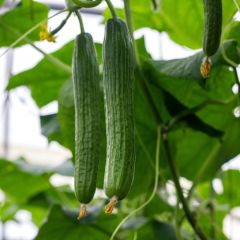
Cucumber Carmen - Cucumis sativus
- Flowering time June to August
- Height at maturity 2,50 m
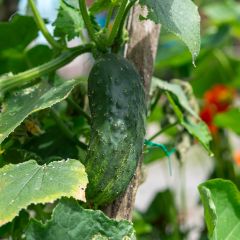
Cucumber Le Généreux - Vilmorin Seeds
- Flowering time June to August
- Height at maturity 2,50 m
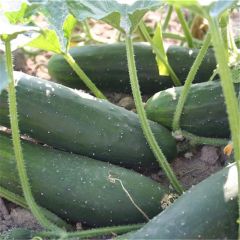
Cucumber Long English - Ferme de Sainte Marthe Seeds
- Flowering time June to August
- Height at maturity 2,50 m
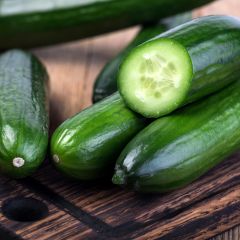
Cucumber Marketmore - Vilmorin Seeds
- Flowering time June to August
- Height at maturity 2,50 m
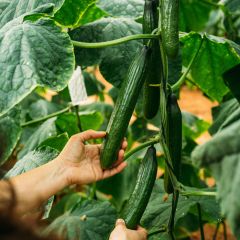
Cucumber Vert Long Maraîcher
- Height at maturity 2,50 m
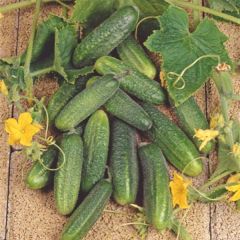
Gherkin Hokus
- Flowering time June to August
- Height at maturity 2,50 m
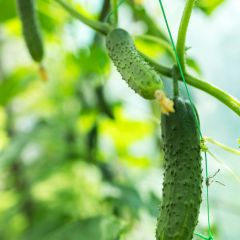
Cucumber Fin de Meaux - Cucumis sativus
- Height at maturity 2,50 m
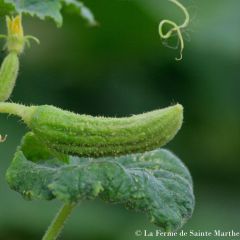
Gherkin Bourbonne - Ferme de Sainte Marthe Seeds
- Height at maturity 2,50 m
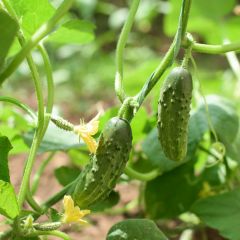
Gherkin Parisian - Ferme de Sainte Marthe Seeds
- Height at maturity 2,50 m
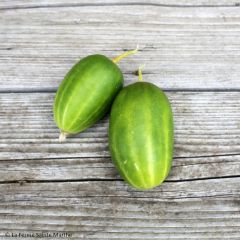
Gherkin Russe - Ferme de Sainte Marthe Seeds
- Flowering time June to August
- Height at maturity 2,50 m
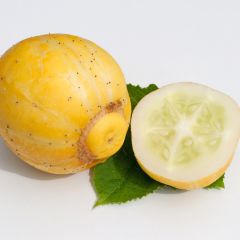
Cucumber Lemon
- Flowering time July to September
- Height at maturity 2 m
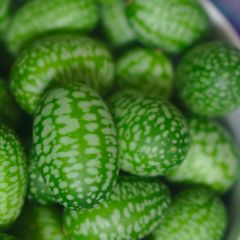
Melothria scabra
- Height at maturity 2,50 m
Discover other Cucumber
View all →Available in 1 sizes
Available in 0 sizes
Available in 1 sizes
Available in 1 sizes
Available in 1 sizes
Available in 1 sizes
Available in 2 sizes
Available in 1 sizes
Available in 1 sizes
Sowing cucumber and gherkin
Where and when to sow cucumbers and gherkins?
Sowing cucumbers and gherkins is preferably done in a hot bucket but can also be done directly in the ground. These vegetables thrive in rich, organic, loose, and deep soils. It is advisable to prepare the bed by adding compost at a rate of 3 to 4 kg per m2.
Cucumbers and gherkins are sown:
- from April to mid-May in a warm environment, indoors or in a heated shelter, under glass or on a hot bed.
- from mid-May to the end of June directly in the ground when the risk of frost has passed.
How to sow cucumbers and gherkins?
You can prepare young plants to be planted in the vegetable garden once all risk of frost has passed or sow directly in place.
Preparing young plants:
- Fill pots or buckets with a special sowing compost,
- Place two seeds per pot (flat) by pushing them down to a depth of about 1 cm and cover with compost,
- Water gently using the spout of the watering can,
- Keep in a warm and light place (on a windowsill), at a temperature of about 20 °C (the germination range for cucumbers is between 16 and 35°C) and maintain the substrate moist but not waterlogged until germination, which usually takes between 7 to 10 days.
- When the two true first leaves (the cotyledons do not count) are well developed, thin out by keeping the best of the two young plants or separate the two young plants and repot them into individual buckets.
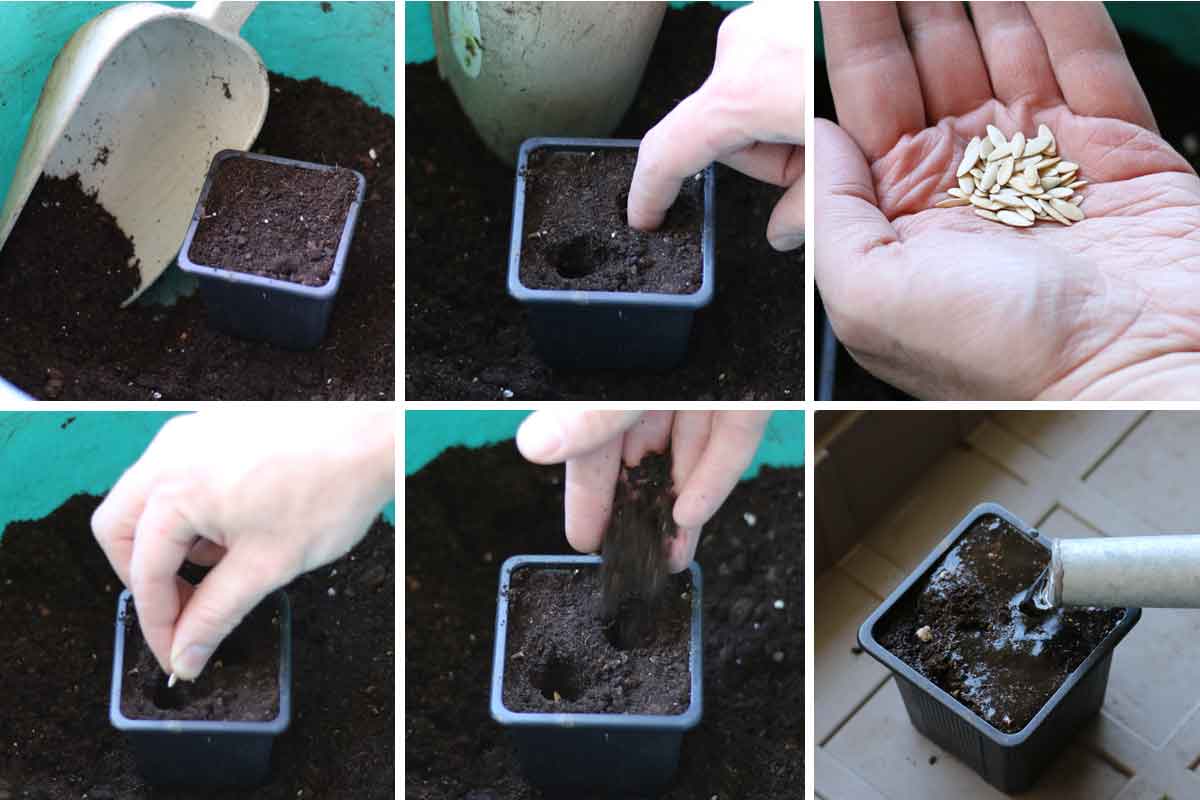 The steps for sowing cucumber and gherkin in buckets[/caption>
The steps for sowing cucumber and gherkin in buckets[/caption>
Sowing directly in the ground:
- Draw shallow furrows (3 cm) spacing the ranks by 1 m.
- Sow in clusters of 2 seeds in each hole.
- Along the row, the clusters should be spaced 1 m apart if the crop is flat or 40 cm for gherkins and 60 cm for cucumbers if the crop is trellised.
- Cover with soil and firm down with the back of the rake.
- Water gently and keep the soil moist until germination.
- When the young plants have reached 2 to 3 true leaves, thin out to keep only one plant per cluster.
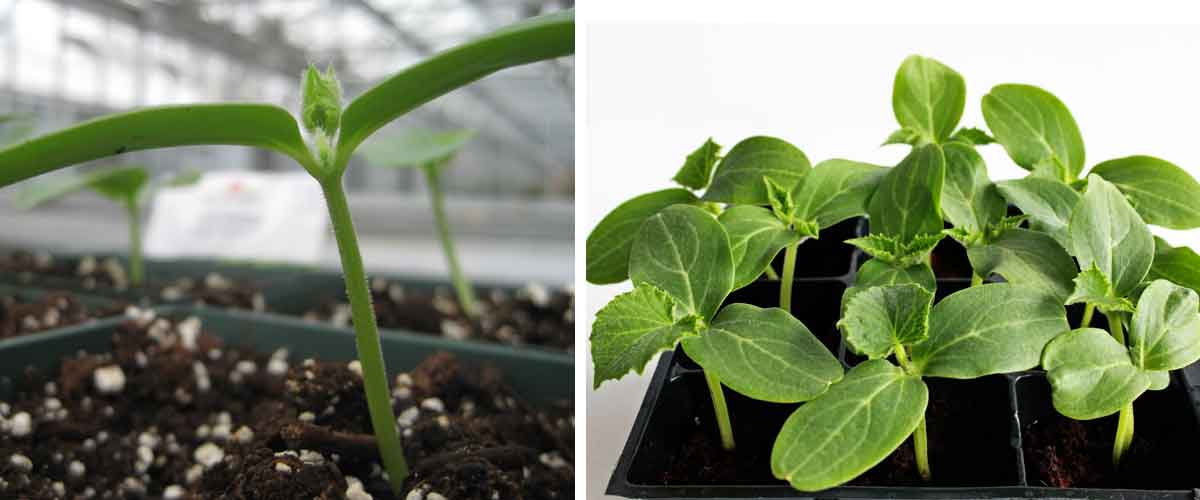 Seedling of cucumber – Cucumbers at the stage of one to two true leaves
Seedling of cucumber – Cucumbers at the stage of one to two true leaves
Read also
LactofermentationPlanting cucumbers and gherkins
When to plant cucumbers and gherkins?
Planting of cucumbers and gherkins should be done from May, preferably after the Ice Saints, in the regions most sensitive to cold. In the South, they can be planted as early as mid-April, monitoring the weather and possibly protecting them from the last frosts with a winter cover. It is possible to continue planting until the end of June.
How to plant cucumbers and gherkins?
These two vegetables require a well-manured soil, previously enriched with about 3 kg of compost or well-rotted manure per m2.
The planting distances are 1 m between the rows for both vegetables. Within the row, the distances are as follows:
- 1 m if the crop is grown flat
- 40 cm for gherkins if the crop is trained
- 60 cm for cucumbers if the crop is trained
To plant your cucumbers and gherkins:
- Dig a hole corresponding to the volume of the root ball,
- Place the root ball and cover it with soil,
- Firm the soil and water to keep it moist,
- To aid recovery, water at the base regularly.
Cultivation, maintenance and companion planting
Cucumbers and gherkins need a sunny exposure to thrive. These greedy vegetables require rich soil, enriched with well-rotted compost (3 kg per m²) at the time of planting or preferably in autumn. This soil should be loosened beforehand, and the compost is incorporated superficially using a rake.
During the growing season, it is good to hoe but not to cultivate too close to the plants. Indeed, the cucumber develops part of its roots near the soil surface, and cultivating destroys this dense root network. Prefer a few hoeings followed by a good layer of mulch as soon as the soil is warm enough, in May or June. Cucumbers and gherkins can be trained, and cucumbers can be pruned; we will detail this part below.
In companion planting, cucumbers appreciate the company of lettuces, which thrive vigorously under cucumbers! The proximity of onions, sweet corn, and beans is also beneficial. However, it is best to avoid placing them next to other Cucurbitaceae and potatoes. The association with tomatoes yields controversial results.
→ Read also: Which plants to associate with cucumber?
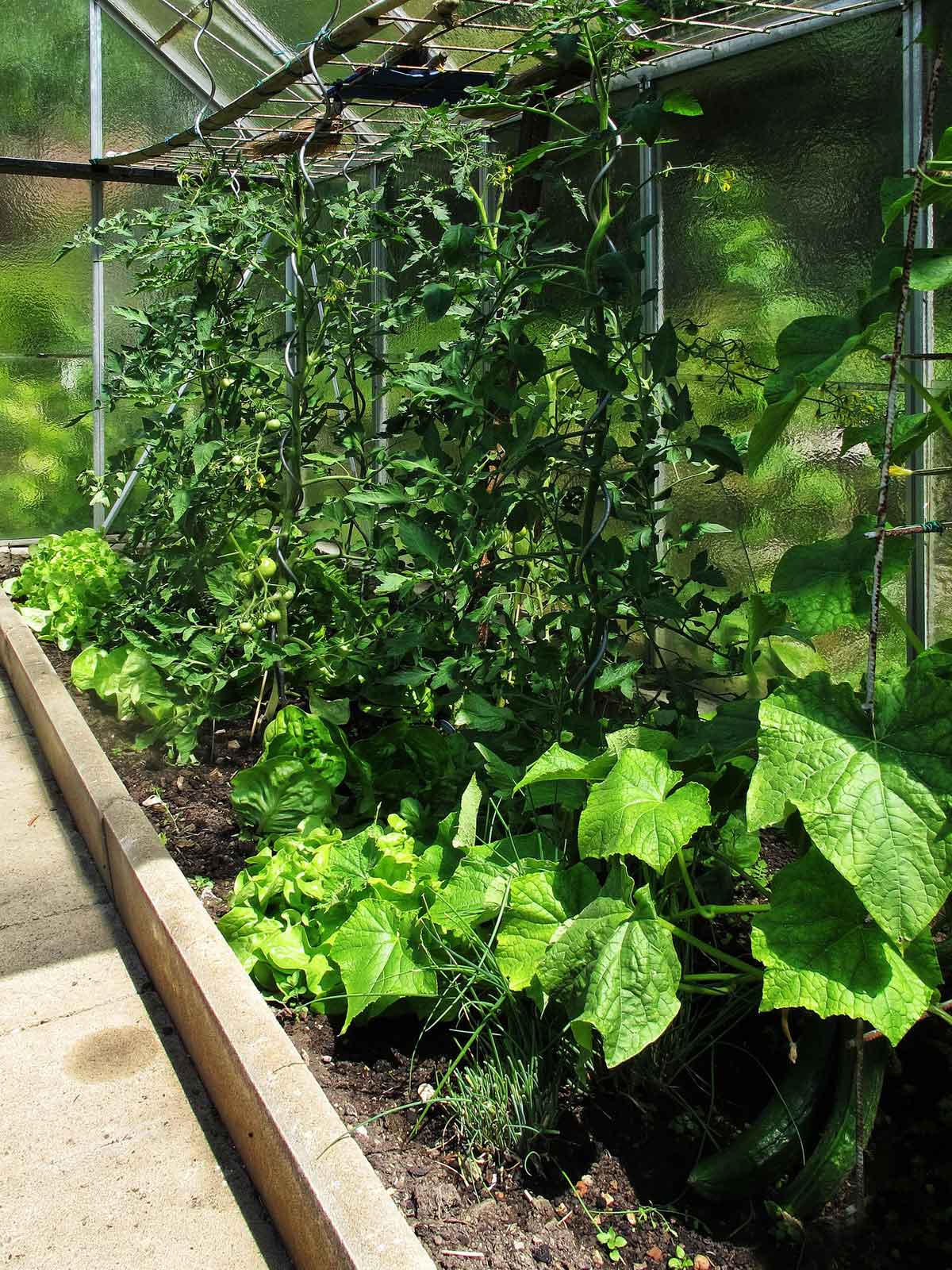
Cucumber grown in a greenhouse near tomato, lettuce, and chive plants.
Supporting and pruning cucumbers and gherkins
Staking Cucumbers and Gherkins
Cucumbers and gherkins can be grown flat on the soil, but to optimise the crops, save space, and facilitate future harvests, do not hesitate to stake or trellis them. There are several options for each crop.
For Cucumbers:
- Using a single stake with one plant per stake.
- On a frame covered with mesh and inclined at 45° to provide shade for heat-sensitive crops like lettuce.
- In a tepee, with 3 to 4 stakes tied together at the top, one plant at the base of each stake.
For Gherkins:
- On a large mesh netting, inclined at 45° or perpendicular to the soil.

Staked gherkins on a large mesh netting and perpendicular to the soil
Pruning Cucumbers
- When plants are individually staked, the crop is conducted on a single stem which will be pinched at a maximum height of 2 m. Side shoots should be removed.
- For flat cultivation, the first pruning is done above the second leaf to obtain two stems, which will themselves be pinched above the 4th leaf.
- When plants are trellised on a lattice, side shoots are trained and retained. We recommend pinching the stems after the formation of 2 or 3 fruits on each side shoot.
Note: Pruning helps concentrate the sap on a few fruits. In the case of gherkins, the aim is to have as many small fruits as possible, so pruning the plant is unnecessary.

Flat cucumber cultivation – Pinch to encourage side shoots – Illustrations: Virginie Douce
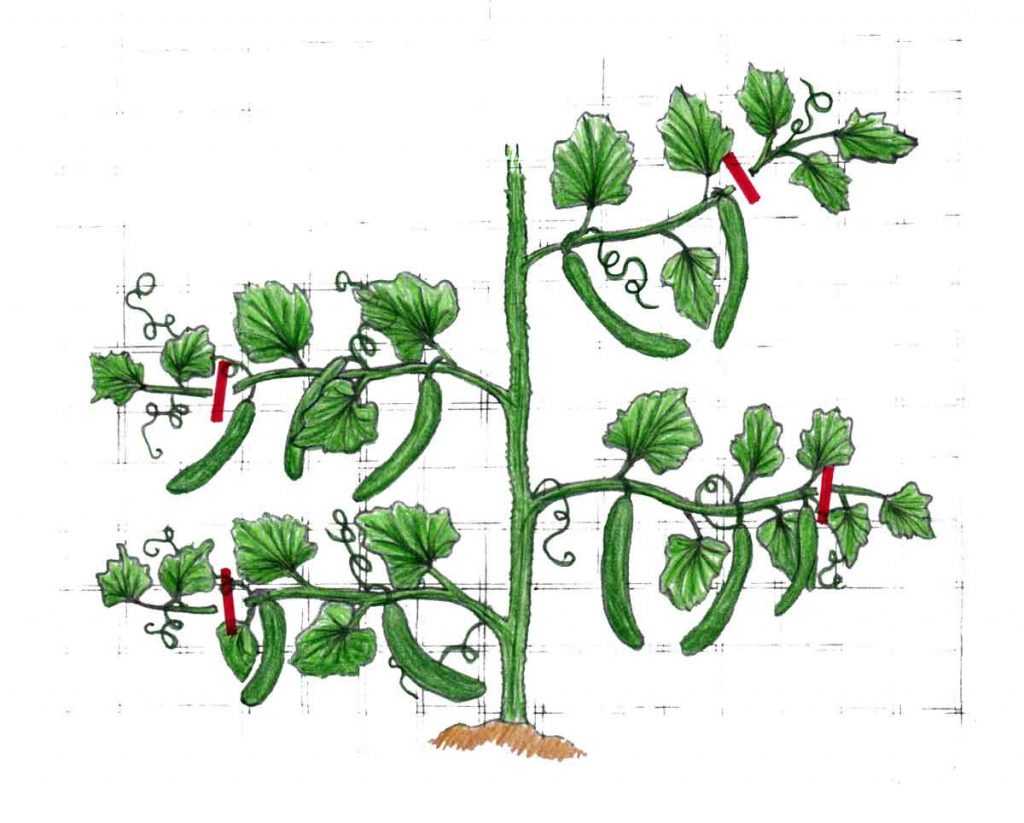 Cultivation and pruning of cucumber on trellis – Illustration: Virginie Douce[/caption>
Cultivation and pruning of cucumber on trellis – Illustration: Virginie Douce[/caption>
Common Diseases of Cucumber and Gherkin
Powdery Mildew of Cucurbits
Cucumbers and gherkins can be susceptible to powdery mildew, a fungal disease that manifests as a white fluff on the foliage. The leaves dry out, production decreases, and in the case of a severe attack, powdery mildew can lead to the death of the plants.
- Discover our advice sheet on preventing and treating powdery mildew
Red Blight or Anthracnose of Cucurbits
Anthracnose or red blight is a fungal disease caused by Colletotrichum orbiculare, which affects Cucurbits in general, particularly cucumbers, gherkins, and melons. The damage can be significant, halting the growth of the plants and potentially causing their death. The symptoms are very characteristic; on the leaves, brown circular spots surrounded by a lighter, yellowish halo can be observed. Anthracnose is favoured by temperatures between 19 and 24°C during highly humid periods.
- Regular attention is necessary, as the spread of the disease can be rapid. If you spot an initial outbreak, cut off the affected leaves and burn them.
- Preventive treatments against powdery mildew (bicarbonate, milk, horsetail) will also help prevent the onset of this disease.
→ Learn more about diseases and pests of cucumbers and gherkins in our advice sheet!
Harvesting and Storing
The harvest of cucumbers, essential for any vegetable garden, is carried out as needed. It is best to pick them when they reach their ideal size or even a little earlier if you prefer to enjoy them without pips. Be careful, a cucumber that starts to yellow becomes bitter, a sign that it has stayed on the plant too long. Regularly picking your cucumbers encourages the plant to produce more fruits. Typically, the harvest begins 3 months after sowing, and a plant can bear fruit for 2 months, providing a generous quantity of cucumbers.
For gherkins, the harvest also starts 3 months after sowing. It is crucial to pick them before they reach their final size, ideally every two days during the peak production period, to prevent them from becoming too large. Just like with cucumbers, frequent picking promotes the growth of new fruits, ensuring a bountiful harvest throughout the season.
As for storage, cucumbers can last up to 8 days in the refrigerator. For prolonged storage, especially in the case of a bountiful harvest, consider lacto-fermentation or vinegar preservation, techniques that are also applicable to gherkins. Once harvested, gherkins can stay fresh for a few days before being pickled in vinegar, allowing you to enjoy the characteristic crunchy and tangy taste of gherkins throughout the year.

Cucumbers at the right stage for harvest – Harvesting gherkins to preserve them pickled in vinegar
Uses and nutritional benefits
Cucumber is mainly consumed raw in summer salads, pairing very well with sauces made from yoghurt or cream, lemon, and fresh herbs from the garden such as chives and dill. Cooked preparations are less common but possible; a few minutes in the pan is sufficient. Juices made with a centrifugal juicer are also common, ideal as part of a dietary regime. Gherkins are in the vast majority of cases pickled in vinegar, and it is clearly in this way that they are at their best!
Cucumber and gherkin are low-calorie vegetables that consist mainly of water (95%) and are very rich in minerals (calcium, potassium, iron, magnesium). Water is more present in cucumber as gherkin is drained before being pickled. Cucumber is therefore a remineralising and refreshing vegetable for the body. They also contain antioxidants, including citrulline, an amino acid that aids in muscle protein synthesis (though watermelon naturally contains the most of this amino acid). Their skin is perfectly edible once well washed, as it is rich in pepsin which aids digestion; it would be a shame to miss out on it!
Frequently asked questions
-
Why are my cucumber plants producing very few fruits?
Cucumber young plants that produce little are most likely poorly pollinated. To achieve good yields: - ensure you attract pollinating insects to your garden by sowing attractive flowers, - avoid pesticidal products.
-
Why are the leaves of my cucumbers all white?
It is most likely powdery mildew, a common disease in cucumbers and Cucurbitaceae. See above (paragraph on common cucumber and gherkin diseases) for prevention and treatment of this disease.
- Subscribe!
- Contents
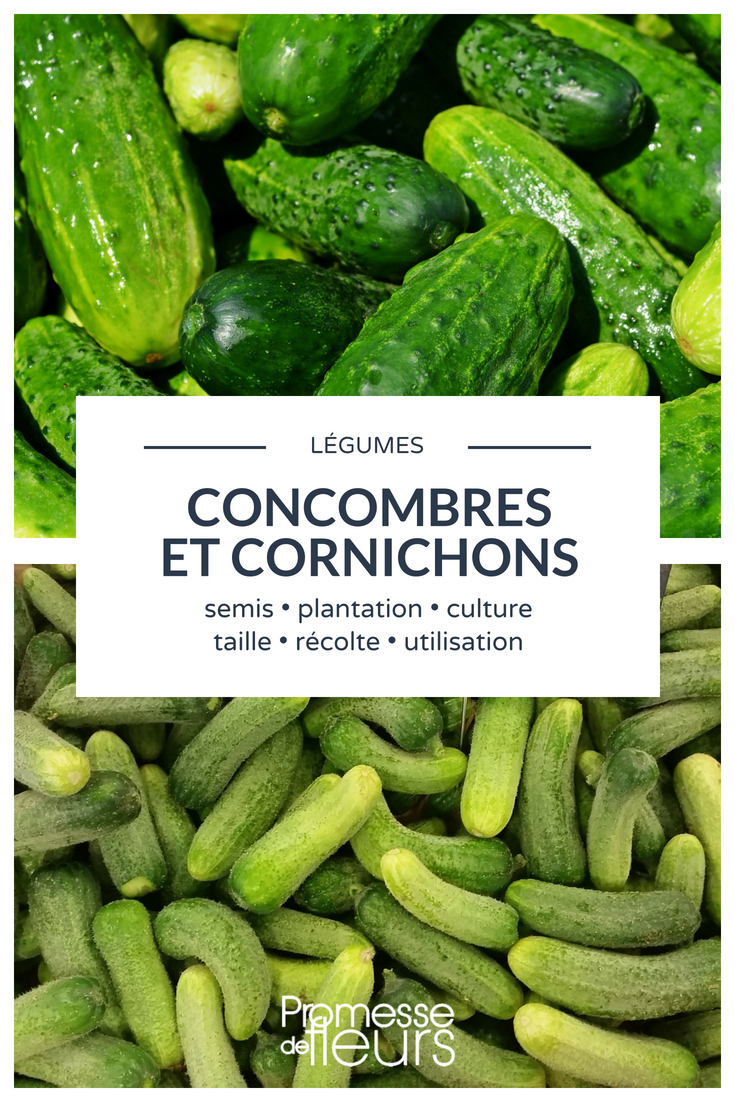































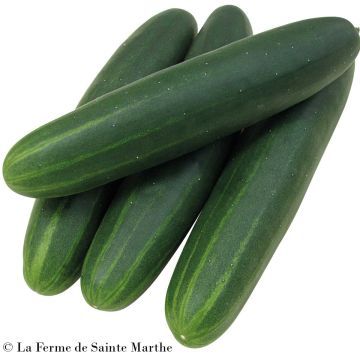
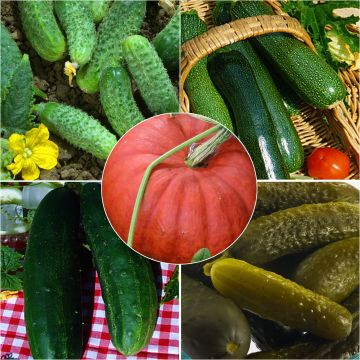

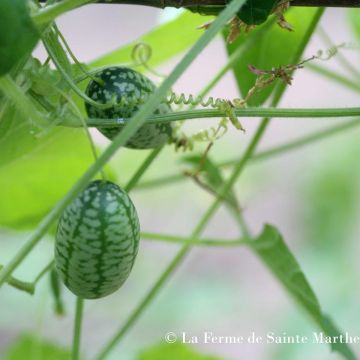
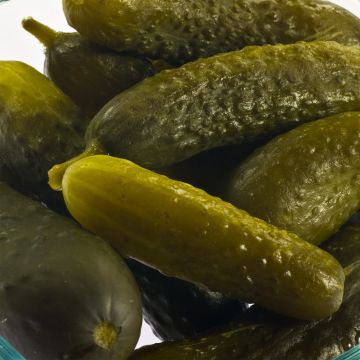
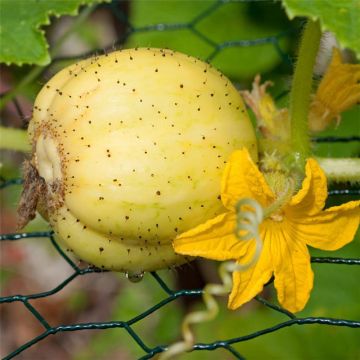
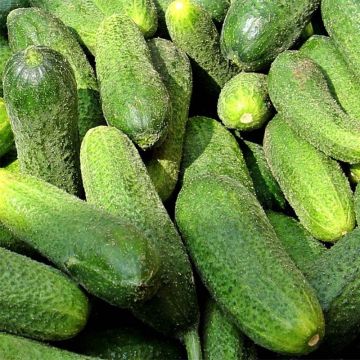
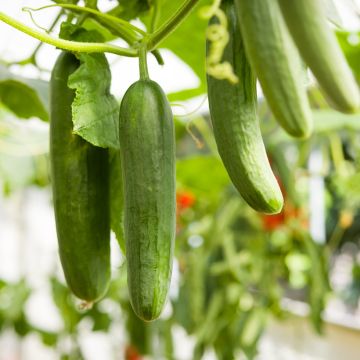

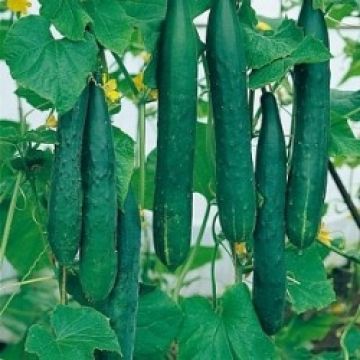
Comments